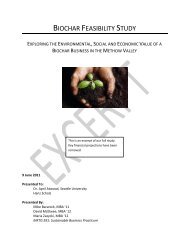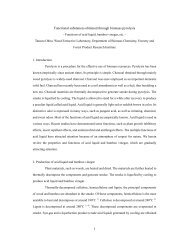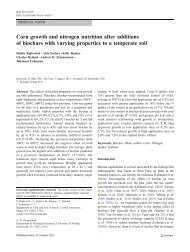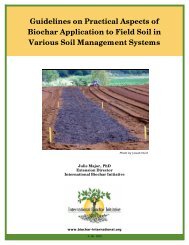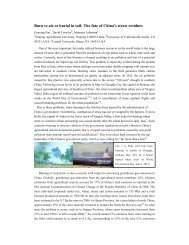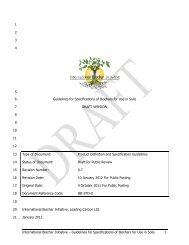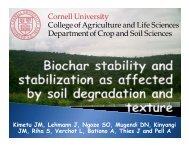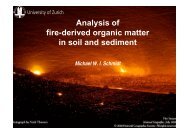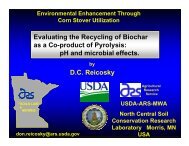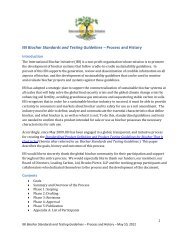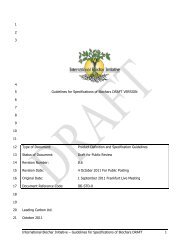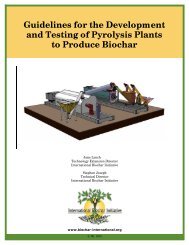Biochar in Mixtures - International Biochar Initiative
Biochar in Mixtures - International Biochar Initiative
Biochar in Mixtures - International Biochar Initiative
You also want an ePaper? Increase the reach of your titles
YUMPU automatically turns print PDFs into web optimized ePapers that Google loves.
IBI Research Summary:<br />
<strong>Biochar</strong> <strong>in</strong> <strong>Mixtures</strong><br />
Updated: January 2011<br />
Author: Julie Major, PhD<br />
Note: IBI Research Summaries are <strong>in</strong>tended to provide answers about biochar science<br />
for the general public. These summaries are based on IBI’s review of published scientific<br />
literature. As this literature is updated, IBI will update these summaries. Please contact<br />
IBI at <strong>in</strong>fo@biochar-<strong>in</strong>ternational.org if you have questions or <strong>in</strong>formation to share.<br />
The role of mixtures <strong>in</strong> biochar<br />
Although biochar can be used to improve soils over the long term, it is not a long-term<br />
source of nutrients. Depend<strong>in</strong>g on the feedstock and pyrolysis conditions, biochar can<br />
conta<strong>in</strong> vary<strong>in</strong>g amounts of ash which can provide nutrients for plant growth <strong>in</strong> the short<br />
term. A significant advantage of biochar when added to soil is its recalcitrance and its<br />
ability to reta<strong>in</strong> nutrients which are present <strong>in</strong> soil, or added as fertilizer or decompos<strong>in</strong>g<br />
organic matter, over the long term. <strong>Biochar</strong> has also been shown to support soil<br />
microorganisms through its highly porous structure which provides protection from<br />
predators and access to water and nutrients (Thies and Rillig, 2009). Consequently, a<br />
number of researchers <strong>in</strong> academia and <strong>in</strong>dustry are prepar<strong>in</strong>g and test<strong>in</strong>g mixes of<br />
biochar with nutrients and/or cultures of bacteria or fungi, <strong>in</strong> order to improve the<br />
nutrient content of biochar immediately upon addition to soil.<br />
This research summary is a review of data available <strong>in</strong> the published scientific literature<br />
and other sources, regard<strong>in</strong>g the effect of biochar on the production of compost, biochar<br />
mixtures with manure, and the use of biochar <strong>in</strong> a microbial ferment called Bokashi.<br />
<strong>Biochar</strong> as an <strong>in</strong>gredient <strong>in</strong> Bokashi<br />
Bokashi is a traditional Japanese soil amendment that is now used <strong>in</strong> various places<br />
around the world. Although there are various recipes for mak<strong>in</strong>g Bokashi (<strong>in</strong>gredient lists<br />
can be adapted to the materials available <strong>in</strong> each region, <strong>in</strong>clud<strong>in</strong>g locally sourced<br />
microorganisms), it can be made by comb<strong>in</strong><strong>in</strong>g microbes (termed “effective<br />
microorganisms”, or “EM”), molasses, biochar, bran and animal manure with water<br />
(Reap Canada). Bokashi can be made either anaerobically (i.e. by fermentation <strong>in</strong> closed<br />
vessels) or partially aerobically, similarly to normal compost<strong>in</strong>g (Formowitz et al., 2007),<br />
or us<strong>in</strong>g a comb<strong>in</strong>ation of both.<br />
IBI Research Summary – <strong>Biochar</strong> <strong>in</strong> <strong>Mixtures</strong> – January 2011 page 1
Some researchers found better yield of peanuts and greater numbers and total biomass of<br />
nitrogen-fix<strong>in</strong>g nodules on peanut roots when Bokashi was used <strong>in</strong>stead of synthetic<br />
fertilizer (Yan and Xu, 2002). However, Formowitz et al. (2007) showed that the<br />
“effective microorganisms” were not likely responsible for beneficial effects of the<br />
material on plant growth, and similar observations were made <strong>in</strong> field crops grown over<br />
four years <strong>in</strong> central Europe (Mayer et al., 2008). However, the Bokashi made by<br />
Formowitz et al. (2007) did not <strong>in</strong>clude biochar, and the reports by Yan and Xu (2002)<br />
and Mayer et al. (2008) do not provide details on the materials used to make Bokashi and<br />
whether or not biochar was used. Thus while Bokashi was found to provide plant growth<br />
benefits <strong>in</strong> these studies, and these benefits could not be attributed to EM, there are no<br />
reports <strong>in</strong> the literature about the role of biochar <strong>in</strong> Bokashi mixtures. Nevertheless,<br />
biochar-conta<strong>in</strong><strong>in</strong>g Bokashi has been used successfully for over 15 years for grow<strong>in</strong>g<br />
vegetables <strong>in</strong> Costa Rica (IBI Practitioner Profile, 2010) and used by farmers <strong>in</strong> the<br />
Philipp<strong>in</strong>es, as outl<strong>in</strong>ed <strong>in</strong> Jensen et al (2006), as one example.<br />
<strong>Biochar</strong> as a medium for fungal <strong>in</strong>oculants<br />
Peat is commonly used as a carrier for rhizobial <strong>in</strong>oculant. Rhizobia are bacteria used to<br />
promote proper nodulation and biological nitrogen fixation <strong>in</strong> legume crops. However,<br />
peat is not available <strong>in</strong> all regions and is arguably not a renewable resource s<strong>in</strong>ce its<br />
formation takes a very long time. <strong>Biochar</strong> can also be used as a carrier for microbial<br />
<strong>in</strong>oculants. Stephens and Rask (2000) <strong>in</strong>dicate that carriers for microbial <strong>in</strong>oculants<br />
should, among other factors, support the growth of the target organisms, have high<br />
moisture hold<strong>in</strong>g and retention capacity, and be environmentally safe. Properly produced<br />
biochar has these characteristics. When test<strong>in</strong>g the survival rate of rhizobial <strong>in</strong>oculum,<br />
charcoal performed similarly to peat, oil and other carriers (Kremer and Peterson, 1983).<br />
Similar results were found by Sparrow and Ham (1983), where rhizobial <strong>in</strong>oculant<br />
survival rates were greater <strong>in</strong> peat, charcoal and vermiculite than <strong>in</strong> peanut hulls or corn<br />
cobs. Mycorrhizae are another type of fungus which also forms symbiotic associations<br />
with plants, and soil-applied biochar has often been demonstrated to be beneficial to<br />
mycorrhizal fungi (reviewed by Warnock et al., 2007), although neutral effects have also<br />
been observed (Habte and Antal, 2010).<br />
<strong>Biochar</strong> as a “bulk<strong>in</strong>g agent” <strong>in</strong> compost<br />
Studies to date show that the compost<strong>in</strong>g process can be accelerated by add<strong>in</strong>g biochar to<br />
poultry manure (Dias et al., 2009; Ste<strong>in</strong>er et al., 2010). For example, maximum<br />
temperatures of the compost were reached faster when biochar was applied (Ste<strong>in</strong>er et al.,<br />
2010) and the degree of humification of the result<strong>in</strong>g compost was greater (Dias et al.<br />
2009) with biochar application. Ste<strong>in</strong>er et al. (2010) assumed that biochar did not<br />
decompose dur<strong>in</strong>g the 42 day trial, and found that the loss of poultry manure biomass was<br />
not different <strong>in</strong> cases where biochar was added as 0, 5 or 20% of the mixture on a dry<br />
weight basis. Dias et al. found that total mass loss <strong>in</strong> their 1:1 by wet weight mixture of<br />
biochar and poultry litter was <strong>in</strong>termediate compared to equivalent mixtures with coffee<br />
husks and sawdust (coffee husks as a bulk<strong>in</strong>g agent caused greater losses and sawdust<br />
caused lower losses relative to biochar), and alluded to the fact that biochar could have<br />
IBI Research Summary – <strong>Biochar</strong> <strong>in</strong> <strong>Mixtures</strong> – January 2011 page 2
undergone decomposition, although their data did not allow this to be determ<strong>in</strong>ed. More<br />
research is needed on the effect of biochar on the C and mass balance dur<strong>in</strong>g compost<strong>in</strong>g;<br />
however a faster “ripen<strong>in</strong>g” of compost as demonstrated by both authors is desirable for<br />
compost makers.<br />
Total nitrogen losses over 42 days of compost<strong>in</strong>g sewage sludge were reduced by 64% by<br />
add<strong>in</strong>g 9% biochar to the sludge (Hua et al., 2009) as opposed to a control not receiv<strong>in</strong>g<br />
biochar. Add<strong>in</strong>g 20% biochar to poultry litter reduced ammonia emissions by 64% over<br />
42 days (Ste<strong>in</strong>er et al. 2010) compared to a non-amended control. Dias et al. (2009) found<br />
that N losses when us<strong>in</strong>g biochar as a bulk<strong>in</strong>g agent were lower than when coffee husks<br />
were used, but greater than when sawdust was used as a bulk<strong>in</strong>g agent. These results are<br />
promis<strong>in</strong>g, especially consider<strong>in</strong>g the recalcitrance of biochar <strong>in</strong> soil compared to other<br />
bulk<strong>in</strong>g agents, and the potential for biochar to reduce odors <strong>in</strong> compost and reta<strong>in</strong><br />
<strong>in</strong>organic N aga<strong>in</strong>st leach<strong>in</strong>g, after soil application. Indeed Ste<strong>in</strong>er et al. (2007) found<br />
greater yield of maize and sorghum on an acid soil after four years when biochar was<br />
applied with compost as opposed to be<strong>in</strong>g applied with synthetic fertilizer.<br />
Dr Makoto Ogawa of the Osaka Institute of Technology <strong>in</strong> Japan states: “Mak<strong>in</strong>g<br />
compost from litter and excretions has been common <strong>in</strong> Japan for a long time. In the<br />
1980s, charcoal compost was made from fresh chicken dung and palm shell charcoal; the<br />
more charcoal used, the faster the compost<strong>in</strong>g process. Under aerobic conditions the<br />
Bacillus group became dom<strong>in</strong>ant and produced antibiotics that <strong>in</strong>hibited growth of soilborne<br />
pathogens and suppressed root diseases. Charcoal compost is now sold <strong>in</strong> Japan as<br />
a biological fungicide. Various other organic composts are now be<strong>in</strong>g been produced<br />
from livestock excretions and charcoal and sold commercially.” (Ogawa, 2009).<br />
<strong>Biochar</strong> and manure<br />
In a column study, Laird et al. (2010) found that the addition of biochar to manureamended<br />
soil reduced the leach<strong>in</strong>g of nutrients. One method for mix<strong>in</strong>g biochar with<br />
manure is to feed biochar directly to animals. While there are constra<strong>in</strong>ts on the amount<br />
of biochar which can be delivered to soil <strong>in</strong> this way, it can potentially provide other<br />
advantages. It has been known for a long time that add<strong>in</strong>g charcoal or various zeolite-like<br />
materials to the feed of livestock improves their ability to utilize prote<strong>in</strong> and assimilate<br />
prote<strong>in</strong>-derived nitrogen from poor-quality (tann<strong>in</strong>-rich) fodder, most probably via<br />
control of loss of ammonia that is subsequently used for microbial prote<strong>in</strong> synthesis <strong>in</strong> the<br />
rumen. Van et al. (2006) showed that growth rate was 20% greater, and f<strong>in</strong>al animal<br />
weight was 5% greater when goats fed tann<strong>in</strong>-rich Acacia sp. fodder were also fed less<br />
than 1 g bamboo charcoal per kg animal weight per day. This trial lasted 12 weeks. As<br />
suggested by Blackwell et al. (2009) and McHenry (2010), biochar can thus be<br />
“ecologically delivered” to soil as part of the animals’ manure. A technical bullet<strong>in</strong> from<br />
the Food and Fertilizer Technology Center (FFTC, year unknown) <strong>in</strong> Taiwan also<br />
proposes feed<strong>in</strong>g bamboo charcoal to cattle, pigs and poultry to reduce smells <strong>in</strong> barns as<br />
well as provid<strong>in</strong>g other benefits to animal health. Similarly, the Brief Compend on<br />
American Agriculture (an agriculture handbook published <strong>in</strong> 1847) gives the follow<strong>in</strong>g<br />
advice on keep<strong>in</strong>g pigs: “If they are closely conf<strong>in</strong>ed <strong>in</strong> pens give them as much charcoal<br />
IBI Research Summary – <strong>Biochar</strong> <strong>in</strong> <strong>Mixtures</strong> – January 2011 page 3
twice a week as they will eat. This corrects any tendency to disorders of the stomach”<br />
(Allen, 1847). Studies are needed to understand which characteristics ensure biochar is<br />
safe for feed<strong>in</strong>g to animals, the mode of action (adsorption, etc.) and which amounts are<br />
beneficial.<br />
<strong>Biochar</strong> could also conceivably be treated with compost tea, ur<strong>in</strong>e, nutrient-rich effluent,<br />
and other products. The efficacy of such treatments and their value <strong>in</strong> “improv<strong>in</strong>g”<br />
biochar materials has not yet been demonstrated.<br />
References<br />
Allen, R.L., 1847. A Brief Compend of American Agriculture, second edition. C. M. Saxton, New York.<br />
Blackwell, P., Riethmuller, G., Coll<strong>in</strong>s, M., 2009. <strong>Biochar</strong> Application to Soil (Chapter 12). In: Lehmann,<br />
J., Joseph, S. (Eds.), <strong>Biochar</strong> for Environmental Management: Science and Technology.<br />
Earthscan, London, UK, p. 207.<br />
Dias, B.O., Silva, C.A., Higashikawa, F.S., Roig, A., Sanchez-Monedero, M.A., 2009. Use of biochar as<br />
bulk<strong>in</strong>g agent for the compost<strong>in</strong>g of poultry manure: Effect on organic matter degradation and<br />
humification. Bioresource Technology 101, 1239-1246.<br />
FFTC (Food and Fertilizer Technology Center), 14 Wenchow St., Taipei, Taiwan ROC<br />
Tel.: (886 2) 2362 6239 Fax: (886 2) 2362 0478 E-mail: fftc@agnet.org Website:<br />
www.fftc.agnet.org “Use of bamboo charcoal to remove the bad smell of manure” Livestock<br />
PT2002-13.<br />
Formowitz, B., Elango, F., Okumoto, S., Muller, T., Buerkert, A., 2007. The role of "effective<br />
microorganisms" <strong>in</strong> the compost<strong>in</strong>g of banana (Musa ssp.) residues. Journal of Plant Nutrition and<br />
Soil Science-Zeitschrift Fur Pflanzenernahrung Und Bodenkunde 170, 649-656.<br />
Habte, M., Antal, M.J., 2010. Reaction of mycorrhizal and nonmycorrhizal Leucaena leucocephala to<br />
charcoal amendment of mansand and soil. Communications <strong>in</strong> Soil Science and Plant Analysis 41,<br />
540-552.<br />
Hua, L., Wu, W.X., Liu, Y.X., McBride, M., Chen, Y.X., 2009. Reduction of nitrogen loss and Cu and Zn<br />
mobility dur<strong>in</strong>g sludge compost<strong>in</strong>g with bamboo charcoal amendment. Environ. Sci. Pollut. Res.<br />
16, 1-9.<br />
<strong>International</strong> <strong>Biochar</strong> <strong>Initiative</strong>, onl<strong>in</strong>e <strong>in</strong>formation at http://www.biochar<strong>in</strong>ternational.org/projects/practitioner/profiles<br />
Jensen, H., Guilaran, L., Jaranilla, R., and Gar<strong>in</strong>galao G. 2006. APPENDIX 6<br />
NATURE FARMING MANUAL. A handbook of preparations, techniques and organic<br />
amendments <strong>in</strong>spired by Nature Farm<strong>in</strong>g and adapted to locally available materials and needs <strong>in</strong><br />
the Western Visayas region of the Philipp<strong>in</strong>es. PABINHI-Pilip<strong>in</strong>as and Reap-Canada.<br />
Kremer, R.J., Peterson, H.L., 1983. Effects of carrier and temperature on survival of rhizobium spp <strong>in</strong><br />
legume <strong>in</strong>ocula – development of an improved type of <strong>in</strong>oculant. Applied and Environmental<br />
Microbiology 45, 1790-1794.<br />
Laird, D., Flem<strong>in</strong>g, P., Wang, B.Q., Horton, R., Karlen, D., 2010. <strong>Biochar</strong> impact on nutrient leach<strong>in</strong>g from<br />
a Midwestern agricultural soil. Geoderma 158, 436-442.<br />
Mayer, J., Scheid, S., Oberhlozer, H.R., 2008. How effective are ‘Effective Microorganisms’? Results from<br />
an organic farm<strong>in</strong>g field experiment. 2nd ISOFAR Scientific Conference of the 16th IFOAM<br />
Organic World Congress, Modena, Italy.<br />
McHenry, M.P., 2010. Carbon-based stock feed additives: a research methodology that explores<br />
ecologically delivered C biosequestration, alongside live weights, feed use efficiency, soil nutrient<br />
retention, and perennial fodder plantations. Journal of the Science of Food and Agriculture 90,<br />
183-187.<br />
Ogawa, M. 2009. Charcoal use <strong>in</strong> agriculture <strong>in</strong> Japan. Keynote address, 1st Asia Pacific <strong>Biochar</strong><br />
Conference, May 17-20 2009, Gold Coast, Australia.<br />
IBI Research Summary – <strong>Biochar</strong> <strong>in</strong> <strong>Mixtures</strong> – January 2011 page 4
Reap Canada, onl<strong>in</strong>e <strong>in</strong>formation available at: http://www.reap-canada.com/bio_and_climate_3_4.htm.<br />
Last accessed 8 February 2010.<br />
Sparrow, S.D., Ham, G.E., 1983. SURVIVAL OF RHIZOBIUM-PHASEOLI IN 6 CARRIER<br />
MATERIALS. Agronomy Journal 75, 181-184.<br />
Ste<strong>in</strong>er, C., Das, K.C., Melear, N., Lakly, D., 2010. Reduc<strong>in</strong>g Nitrogen Loss dur<strong>in</strong>g Poultry Litter<br />
Compost<strong>in</strong>g Us<strong>in</strong>g <strong>Biochar</strong>. J.Environ.Qual.<br />
Ste<strong>in</strong>er, C., Teixeira, W.G., Lehmann, J., Nehls, T., de Macedo, J.L.V., Blum, W.E.H., Zech, W., 2007.<br />
Long term effects of manure, charcoal and m<strong>in</strong>eral fertilization on crop production and fertility on<br />
a highly weathered Central Amazonian upland soil. Plant and Soil 291, 275.<br />
Stephens, J.H.G., Rask, H.M., 2000. Inoculant production and formulation. Field Crops Research 65, 249-<br />
258.<br />
Thies, J.E., Rillig, M.C., 2009. Characteristics of <strong>Biochar</strong> - Biological Properties (Chapter 6). In: Lehmann,<br />
J., Joseph, S. (Eds.), <strong>Biochar</strong> for Environmental Management: Science and Technology.<br />
Earthscan, London, UK, p. 85.<br />
Van, D.T.T., Mui, N.T., Led<strong>in</strong>, I., 2006. Effect of method of process<strong>in</strong>g foliage of Acacia mangium and<br />
<strong>in</strong>clusion of bamboo charcoal <strong>in</strong> the diet on performance of grow<strong>in</strong>g goats. Animal Feed Science<br />
and Technology 130, 242-256.<br />
Warnock, D.D., Lehmann, J., Kuyper, T.W., Rillig, M.C., 2007. Mycorrhizal responses to biochar <strong>in</strong> soil -<br />
concepts and mechanisms. Plant and Soil 300, 9.<br />
Yan, P.S., Xu, H.L., 2002. Influence of EM bokashi on nodulation, physiological characters and yield of<br />
peanut <strong>in</strong> nature farm<strong>in</strong>g fields. Journal of Susta<strong>in</strong>able Agriculture 19, 105-112.<br />
IBI Research Summary – <strong>Biochar</strong> <strong>in</strong> <strong>Mixtures</strong> – January 2011 page 5



